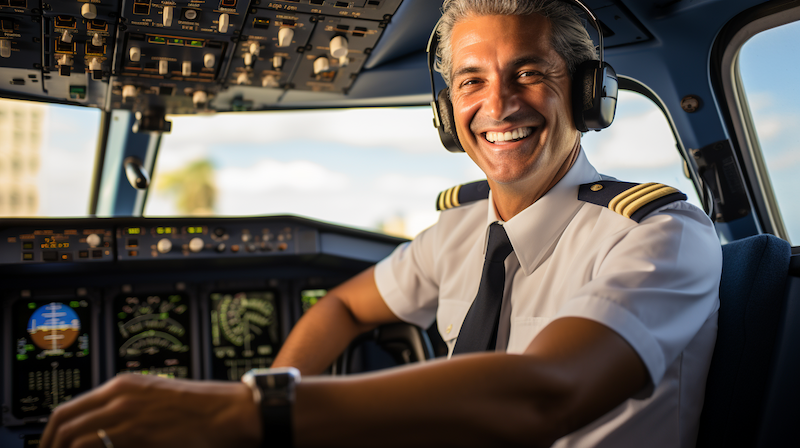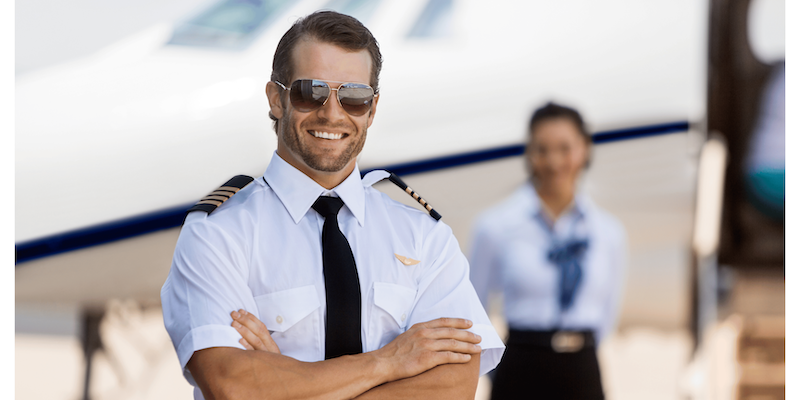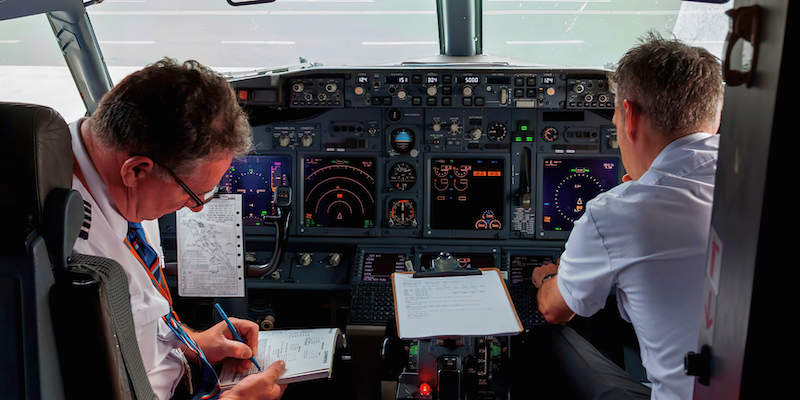When it comes to commercial airline operations, the roles of the captain and first officer are often misunderstood. Though both pilots occupy the cockpit and have similar responsibilities, there are distinct differences between each role. In short, a captain is responsible for overseeing all aspects of flight while a first officer assists in navigation and executing other tasks as instructed by the captain.
The primary difference between these two positions lies in their respective levels of experience and authority during flight. The captain is always an experienced pilot with superior knowledge about aircraft operation who ultimately makes all decisions regarding safety measures or alternate plans during any phase of flight. On the other hand, a first officer’s job is to support the captain by providing assistance in navigation, communication with air traffic controllers, monitoring systems on board and carrying out instructions given by the commander without questioning them.
Who is a First Officer and what is their role in flight operations?

A First Officer, also known as a co-pilot, is an integral member of the flight crew that pilots an aircraft alongside the captain. This can be termed as the entry level position into the cockpit of airline flight.
The First Officer serves many important roles within the cockpit and is responsible for assisting and supporting the captain in all facets of flying. They are also responsible for monitoring the aircraft systems, navigation, communications, and flight instruments.
They are also responsible for performing various checklists prior to and during the flight, as well as troubleshooting any potential issues that may arise. In addition, they can provide additional support in case of an emergency situation or when the captain is absent from the cockpit.
A First Officer is a key member of the team and plays a very important role in ensuring safe, efficient flights. By working closely together with the captain, they create a dependable and successful team that promotes safety and confidence in the air.
Roles and Responsibilities of a First Officer in the Cockpit of a Commercial Airline:
• Assist and support the captain in all aspects of flying
• Monitor aircraft systems, navigation, communications, and flight instruments
• Perform various checklists prior to and during the flight
• Troubleshoot potential issues that may arise
• Provide additional support in case of an emergency situation or when the captain is absent from the cockpit
• Work closely with the captain to create a dependable team that promotes safety and confidence during flights
• Ensure adherence to all applicable Federal Aviation Regulations and airline policies.
The First Officer is an important part of the team in the cockpit, and plays a vital role in ensuring safe, efficient flights. With their knowledge and experience, they are able to work closely with the captain to ensure that every flight is successful. They truly
Who is a Captain and what is their role in flight operations
A captain in the cockpit of a commercial aircraft is the leader of the flight crew and has overall responsibility for safety, comfort, and efficiency throughout the flight. A captain will always start off as a First Officer in the airline and move up to the level of captain based on the seniorty level in that particular airline. A captain is the highest rank a pilot can acheive.
The primary role of the captain is to oversee all aspects of the flight, such as navigation, communication, fuel management, and weather. They must also check that all pre-flight procedures are completed accurately and that the aircraft and crew are ready for flight.
The captain is also responsible for making all critical decisions regarding the safe operation of the aircraft, including emergency response. Finally, they must ensure that Federal Aviation Regulations (FAR) and airline policies are adhered to at all times. In essence, a captain is the most experienced and trusted member of the flight crew.
Roles and Responsibilities of a captain in the Cockpit of a Commercial Airline:
- Ensure the aircraft is properly prepared and ready for flight
- Oversee all aspects of the flight, including navigation, communication, fuel management, and weather
- Inspect that all preflight procedures are completed accurately
- Make critical decisions regarding the safe operation of the aircraft in all situations
- Respond to emergencies appropriately
- Maintain compliance with Federal Aviation Regulations (FAR) and airline policies at all times
- Provide leadership to ensure a successful flight journey for passengers
- Engage closely with First Officer to create a dependable team that promotes safety and confidence during flights.
How are the roles of First Officer and Captain complementary to each other
The difference between a captain and a first officer in commercial airline operations is significant, as they play complementary roles that help to ensure safe and efficient flight operations.
A captain is the most experienced crewmember on board a commercial aircraft and is responsible for making all critical decisions regarding the safe operation of the aircraft. A captain must have extensive knowledge of aviation regulations, aircraft systems, and flight operations. They must also be highly adept at responding to emergencies appropriately.
A first officer works in tandem with the captain to ensure that all preflight procedures are completed accurately and that all missions objectives are met. The first officer is responsible for handling communications, navigation, fuel management, and other aspects of the flight operation. With their expertise, they provide leadership to ensure a successful flight journey for passengers.
The roles of the captain and first officer are complementary to each other; by leveraging their combined experience and knowledge, they can help ensure safe and efficient flight operations. This is done through thorough communication between the two crew members, attention to detail in preflight preparation, and continuous collaboration throughout the mission. This collaboration helps to create a dependable team that promotes safety and confidence during flights.
For commercial airline operations, the captain and first officer are an integral part of any successful flight crew. With their combined expertise, they can help ensure safe and efficient flight operations for all passengers aboard!
How does a first officer become a Captain in an airline
In a pilot career, one usually starts from being a first officer in the airline and then gets promoted to the captain level. A first officer can become a Captain of by meeting certain criteria. First and foremost, one needs to have extensive experience in flying. This includes the completion of thousands of flight hours, often with multiple airlines on different types of aircraft.
The main requirement by any airline is for the pilot to have the country’s Civil Aviation Authority issued Airline Transport Pilot Licence (ATPL or ATP) which will need 1500 hours of total flying hours, in addition to other requirements like written exams, medicals and required ratings. The majority of these flight hours need to be accumulated as a first officer before the pilot can progress to the role of captain.
Additionally, airlines may also require formal training on their specific aircraft and procedures in order to become a captain, as well as an understanding of aviation regulations. Once these requirements have been met and a minimum number of years with the airline have passed, pilots may be eligible for promotion to captain based on seniority or total flying hours accumulated at the airline.
It is important to note that, while experience and training are essential components of becoming a captain, one must also possess exceptional leadership qualities in order to be successful in this role. The captain has ultimate responsibility for the flight crew, passengers, and aircraft during every journey – making it vital that they have a high level of situational awareness and sound decision-making skills to ensure everyone’s safety and comfort.
Some other facts and comparisons between a First officer and a Captain:
When talking about a first officer and a captain of an airline, one might come across many questions. In this section we will explore some other differences between these two positions including their qualifications required for each role.
How to tell a difference between a first officer and a captain?
The tell tale difference between a first officer and a captain can be the found on the uniform the pilot wears. Every pilot has stripes on the shoulders with their uniform. A first officer will have three stripes, while a Captain will have four stripes.
How long does it take for a first officer to become captain?
It usually takes between 3-5 years for a first officer to attain the necessary experience and qualifications in order to become a captain. They must spend most of this time trainings on their specific aircraft and procedures, as well as gaining an understanding of aviation regulations.
However, promotion at the airline is based heavily on seniority and that could mean there are more senior first officers waiting in line before you to get the next vacancy created in that particular airline. For this reason the time for becoming a Captain from being a First Officer can take as little as 3 years but there have been instances that take as long as 15 years.
Can a first officer land a plane without a Captain acting as a pilot in command.
If the situation arises, the First Officers are well trained to safely land a plane in the absence of a Captain in the cockpit. Every pilot is well trained for all kinds of situations to be ready to take control of the flight, so one can be assured that a First Officer is more than capable to just land a flight.
Can a first officer overrule a captain?
When it comes to the flight crew, the captain has ultimate authority and responsibility. This means that they have the final say when making decisions related to the aircraft and its passengers. In certain situations, a first officer may make a recommendation or suggestion to the captain regarding a course of action.
The safety of the flight and its passengers are of utmost importance to both the pilots, so there are still protocols that most airlines follow, where if the safety of the flight is compromised, the first officer gets to take control and safely navigate the situation.
Let’s say a flight landing is compromised in certain way, the first officer can call out the captain stating that the landing is compromised. If no correction, the first officer can then give another chance by making the instruction obvious enough and even then if there is no correction, the first officer can take immediate action as per standard operating procedures to make the flight safe again.
If you would like to know more about aviation career or like to know how to become a pilot click here to read an article I have written.

